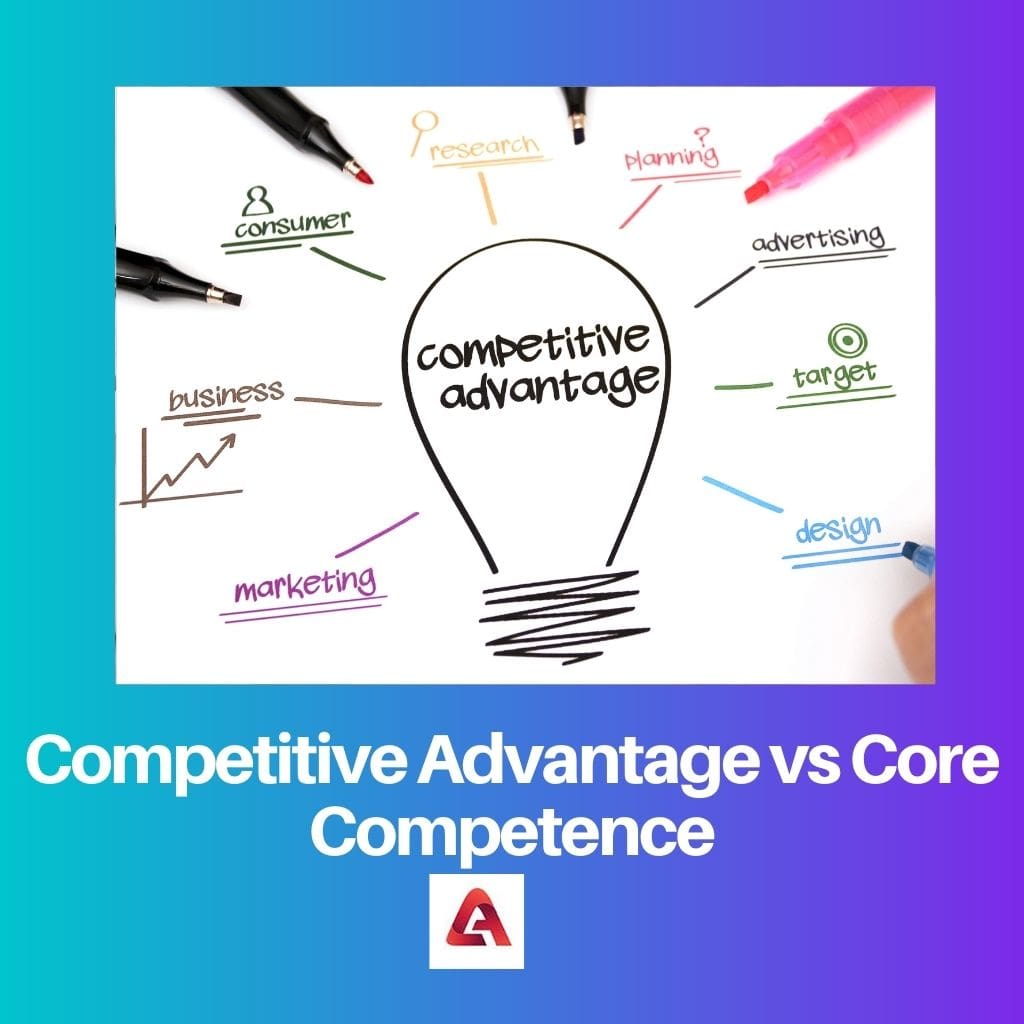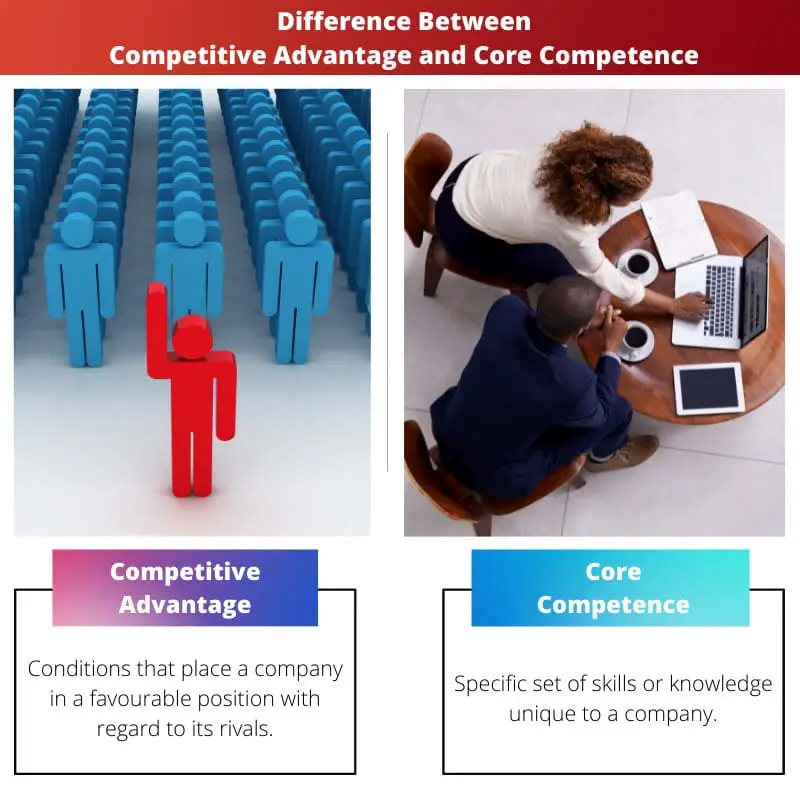Competitive Advantage refers to a company’s unique strengths that set it apart from competitors, enabling it to outperform in the market. Core Competence, on the other hand, signifies the specific capabilities and skills that underpin a company’s competitive advantage, deeply ingrained in its organizational DNA and difficult for rivals to replicate.
Key Takeaways
- Competitive advantage is a set of unique strengths or characteristics that a company possesses that enables it to outperform its competitors.
- Core competence is a specific set of capabilities or resources that a company possesses that enables it to create and deliver value to customers.
- Competitive advantage is focused on relative performance against competitors, while core competence is focused on the specific capabilities that underlie that performance.
Competitive Advantage vs Core Competence
A competitive advantage is a specific advantage that a company has over its competitors, while core competence is a broader concept that encompasses the company’s overall capabilities and expertise. A company’s core competencies can contribute to its competitive advantage by providing values.

Competitive advantage is helpful for competitive strength against competitors, whereas core competence is excellence in various businesses and products.
Comparison Table
| Feature | Competitive Advantage | Core Competence |
|---|---|---|
| Definition | The edge a company has over its competitors in the market, allowing it to perform better and deliver superior value to customers. | The specific skills, knowledge, and expertise a company possesses that are difficult for competitors to imitate and contribute to its competitive advantage. |
| Focus | Outcome: The result of leveraging core competencies to achieve a stronger market position. | Building Block: The fundamental capabilities that contribute to the competitive advantage. |
| Sustainability | Can be temporary or long-lasting depending on factors like market dynamics and competitor actions. | Aimed at being long-lasting and difficult for competitors to replicate. |
| Examples | Superior brand reputation, cost leadership, innovative product design, efficient supply chain management. | Strong R&D capabilities, exceptional customer service, deep industry knowledge, unique production processes. |
| Relationship | Competitive advantage is achieved by leveraging core competencies. | Core competencies are built to be the foundation for a competitive advantage. |
What is Competitive Advantage?
Competitive Advantage is a central concept in business strategy, referring to the unique strengths and capabilities that enable a company to outperform its competitors in the marketplace. It is the edge that allows a company to generate superior value for its customers and, in turn, achieve profitability and growth that surpasses industry norms.
Sources of Competitive Advantage
- Cost Advantage: This type of competitive advantage arises when a company can produce goods or services at a lower cost than its competitors. This could stem from economies of scale, efficient operations, proprietary technology, or access to low-cost resources.
- Differentiation Advantage: Companies can also gain a competitive edge by offering products or services that are perceived as unique or superior by customers. This could be achieved through product innovation, brand reputation, customer service excellence, or customization capabilities.
Sustaining Competitive Advantage
Maintaining competitive advantage over time is crucial for long-term success. This requires continuous innovation, strategic investments, and adaptability to changing market dynamics. Companies must also be vigilant about competitors’ actions and market shifts to protect and enhance their competitive position.
Examples of Competitive Advantage
- Apple: Known for its innovation in design and technology, Apple has a strong differentiation advantage with its iconic products like the iPhone and MacBook.
- Walmart: Walmart has a significant cost advantage due to its massive scale, efficient supply chain, and purchasing power, allowing it to offer low prices to customers.

What is Core Competency?
Core Competence is a strategic concept that describes the unique set of skills, knowledge, and capabilities that distinguish a company from its competitors. It represents the collective expertise and resources within an organization that enable it to deliver value to customers in ways that competitors cannot easily replicate.
Characteristics of Core Competence
- Strategic Importance: Core competencies are fundamental to a company’s strategy and are central to its ability to achieve competitive advantage. They serve as the foundation for developing new products, entering new markets, or creating innovative solutions.
- Cross-Functional Nature: Core competencies span multiple functions and departments within an organization. They may encompass technical expertise, managerial capabilities, organizational culture, and other intangible assets that contribute to the company’s overall performance.
Developing Core Competence
Developing core competencies requires a strategic focus on cultivating and leveraging the unique strengths of the organization. This may involve investing in employee training and development, fostering a culture of innovation and collaboration, and aligning resources to support core competency development initiatives.
Leveraging Core Competence
- Product Development: Core competencies can be the basis for developing new products or improving existing ones, ensuring that offerings meet customer needs and preferences more effectively than competitors.
- Market Expansion: Companies can leverage their core competencies to enter new markets or expand their presence in existing ones. By leveraging existing strengths, companies can penetrate new segments and outmaneuver competitors.
- Partnerships and Alliances: Core competencies can also be leveraged through strategic partnerships and alliances with other companies. By combining complementary strengths, companies can create value propositions that are difficult for competitors to replicate.
Examples of Core Competence
- Google: Google’s core competency lies in its search algorithm and data analytics capabilities, which enable it to deliver highly relevant search results and targeted advertising to users.
- Toyota: Toyota’s core competence in lean manufacturing and continuous improvement has enabled it to achieve high levels of efficiency, quality, and innovation in its production processes.

Main Differences Between Competitive Advantage and Core Competence
- Nature:
- Competitive Advantage: Focuses on the overall edge a company has over its competitors in the market.
- Core Competence: Refers to specific capabilities and skills deeply embedded within the organization that contribute to its competitive advantage.
- Scope:
- Competitive Advantage: Encompasses the broader picture of how a company positions itself relative to competitors to achieve superior performance.
- Core Competence: Concentrates on the internal capabilities and resources that underpin a company’s competitive advantage.
- Timeframe:
- Competitive Advantage: Can be relatively short-term and subject to change as market conditions, and competitive dynamics evolve.
- Core Competence: Represents more enduring strengths and capabilities that are difficult for competitors to replicate quickly.
- Focus:
- Competitive Advantage: Primarily concerned with the end result of outperforming competitors in the market.
- Core Competence: Focuses on the internal processes, skills, and knowledge that drive the company’s ability to achieve competitive advantage.




